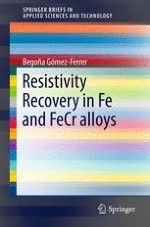The present chapter encloses the primary objective of this research work, at which most of the invested time and efforts have been devoted; this is the design and development of an experimental system to perform in situ RR experiments at the end of one of the beam lines of a Tandetron ion-irradiation facility. Such task requires the acquisition, design and assembling of every component of the setup and the acquisition system, testing of sensors and probes (sensibility and performance), developing of data acquisition program, and optimizing the measurement methodology as well as the data warehousing and treatment. Additionally, a specific method for the specimen preparation and assembly in the developed setup had to be invented. The experimental technique has turned out to be very exigent from a technical point of view as it will be explained along the chapter. As explained in Chap.
2, a classical RR experiment consists of monitoring the residual resistivity
of a metallic sample after irradiation at low temperature. It is measured at cryogenic temperature, typically 4.2−30 K, in order to eliminate the electron–phonon contribution to the resistivity and get a resistivity value dependent on point defects and “ordering” of the sample lattice. The low-temperature irradiation is going to create defects in the sample lattice which would increase its residual resistivity. This phenomenon is called RIR
and has been described above. A step-like thermal annealing subsequent to irradiation will typically lead to a recovery of non-irradiated residual resistivity values providing the RR curves. The derivative of such curve provides indirect information on the migration processes that created defects perform. Hence, information related to damage creation, recombination, and clustering of defects
, both vacancies and interstitials, can be obtained by performing this type of experiments. This section provides a detailed explanation of the experimental techniques and methods used for the resistivity measurements, as the choice of the appropriate probe configuration and measurement methodology is non-straightforward in the case of metallic samples with very low values of electrical
resistance. The four-point probe
technique in the particular configuration of van der Pauw (VdP) [
1] has been chosen to prepare the sample (Sect.
3.1), and the delta method has been used for clean measurement of low voltages by removing the thermoelectric voltage contributions (Sect.
3.2). Beyond these basic concepts, the Sect.
3.3 outlines the requirements and difficulties for undertaking the RR measurements on samples irradiated at cryogenic temperature. The details concerning the sample preparation method, designed in order to fulfill the experimental requirements, is given in Sect.
3.4. An explanation of experimental details and highlight of the technological difficulties needed to be overcome in such experiments are also presented as this discussion is interesting in order to understand the reliability and comparability among results from different authors. In particular, in Sect.
3.5, the design of the sample holder which assembles all the systems for resistivity measurements, heating and temperature monitoring is carefully described as it is a fundamental piece to guarantee the success of the RR measurements. Finally, in Sect.
3.6, an effort has been made to provide good explanation of the measurement details and procedure and to treat the whole uncertainties of a resistivity measurement in a clear and sincere way because in literature this issue is normally omitted. For readers interested in developing their own RR experimental setup, I also recommend, as complementary sources of information, to read the reference literature from former works [
2‐
8].
